
Georgian Dublin is a phrase used in terms of the history of Dublin that has two interwoven meanings:
- to describe a historic period in the development of the city of Dublin, Ireland, from 1714 to the death in 1830 of King George IV. During this period, the reign of the four Georges, hence the word Georgian, covers a particular and unified style, derived from Palladian Architecture, which was used in erecting public and private buildings
- to describe the modern day surviving buildings in Dublin erected in that period and which share that architectural style
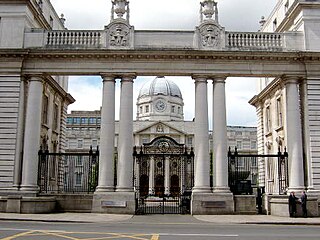
Merrion Street is a major Georgian street on the southside of Dublin, Ireland, which runs along one side of Merrion Square. It is divided into Merrion Street Lower, Merrion Square West and Merrion Street Upper. It holds one entrance to the seat of the Irish Parliament, the Oireachtas, major government offices and two major cultural institutions.
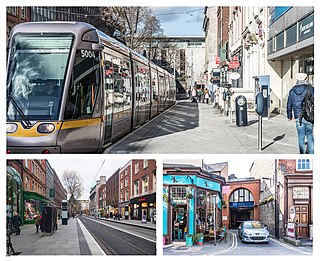
Dawson Street is a street on the southern side of central Dublin, running from St Stephen's Green to the walls of Trinity College Dublin. It is the site of the residence of the Lord Mayor of Dublin, the Mansion House.
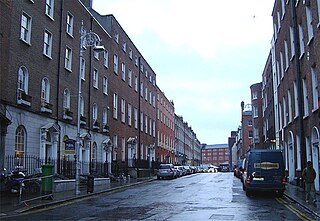
Ely Place is a street in central Dublin with Georgian architecture. It is a continuation of Upper Merrion Street and the place where Lower Baggot Street and Merrion Row meet. Both the latter and Hume Street link it to St Stephen's Green.

Molesworth Street is a street in Dublin, Ireland named after Richard Molesworth, 3rd Viscount Molesworth and links the more notable Dawson Street with Kildare Street and lies just over 200 m to the north of St. Stephens Green in Dublin's central business district.

Gardiner Street is a long Georgian street in Dublin, Ireland. It stretches from the River Liffey at its southern end via Mountjoy Square to Dorset Street at its northern end. The Custom House terminates the vista at the southern end, and the street is divided into Gardiner Street Upper, Gardiner Street Middle and Gardiner Street Lower.

Henry Street is located on Dublin's Northside and is one of the two principal shopping streets of Dublin.

Parnell Street is a street in Dublin, Ireland, which runs from Capel Street in the west to Gardiner Street and Mountjoy Square in the east. It is at the north end of O'Connell Street, where it forms the south side of Parnell Square.

Dame Street is a large thoroughfare in Dublin, Ireland.
Michael Stapleton is regarded as having been the most skilled stuccodore working in the neoclassical or "Adam" style that dominated Dublin interior decoration in the final decades of the 18th century.

Marlborough Street is a street in the city centre of Dublin, Ireland.
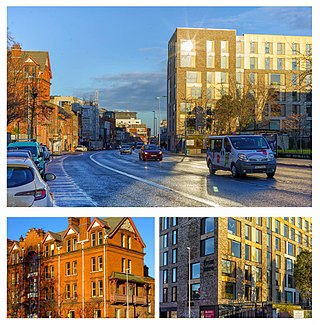
Cork Street runs from the junction of The Coombe to Donore Avenue.
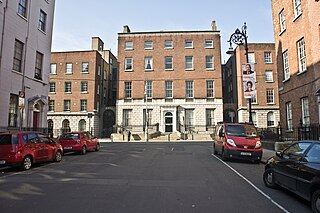
Belvedere House is a historic townhouse located on Great Denmark Street bookending North Great George's Street in Dublin, Ireland. It was built by George Rochfort, 2nd Earl of Belvedere between 1775 and 1786 at a cost of £24,000. The design and stucco of the interior ceilings was carried out by Michael Stapleton, a leading stuccodor and craftsman of his time. In 1841 it became a Jesuit college which houses the school Belvedere College.
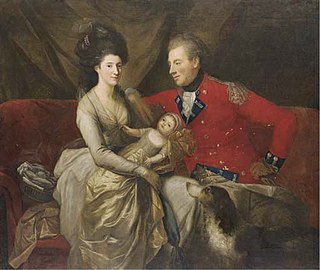
George Augustus Rochfort, 2nd Earl of Belvedere was an Anglo-Irish peer and politician.

Jervis Street is a street on the northside of Dublin, Ireland laid out in the 17th century and named for Sir Humphrey Jervis.

Mary Street is a predominantly retail street in Dublin, Ireland on the northside of the city contiguous with Henry Street.
John Rochfort was a member of the pre-1801 Parliament of Ireland, in the Irish House of Commons.

Eccles Street is a street in Dublin, Ireland.

North Great George's Street is a street on the Northside of Dublin city first laid out in 1766 which connects Parnell Street with Great Denmark Street. It consists of opposing terraces of 4-storey over basement red-brick Georgian townhouses descending on an increasingly steep gradient from Belvedere House which bookends the street from a perpendicular aspect to the North.

Earlsfort Terrace is a street in Dublin, Ireland which was laid out in the 1830s.





















